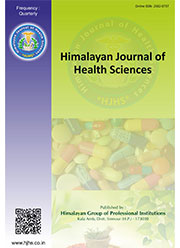Various Types of Basti Karma and their Therapeutic Indications: An Ayurveda Review
Abstract
The various detoxifying techniques recommended by Ayurveda are Vaman, Virechan, Basti, Nasya and Raktamokshana. These all comes under the heading of Panchkarma procedure. Amongst them the Basti Karma is one of the important detoxification measures in which drug is transported through the anal route in the form of medicinal oil or herbal concoction. Enemas are frequently administered to clean the lower bowel in modern medicine as a last option for treating constipation when all other treatments have failed. Instead of this, Basti Karma, which is mentioned in classical Ayurvedic texts, has a wider therapeutic effect on almost all body tissues and has curative, preventive, health-promoting and rejuvenative effects. There are different types of Basti Karma proposed by Ayurveda philosopher which utilizes for various therapeutic purposes. Present article described various types of Basti Karma and their therapeutic indications along with general overview of this ancient technique.
References
2. Sushruta. ‘Sushruta Samhita Chikitsasthana 35/6. 35th chapter, 6th sloka. Varanasi: Chaukhamba Orientalia; 2002.p.545.
3. Agnivesha, Charaka, Dridhabala, Charaka Samhita, Sidhdhi Sthana, 1/40-41. edited by Vaidya Jadavji Trikamji Acharya. 2nd. Edition. Varanasi: Chaukhamba Sanskrit Sansthan; 2008.p.883.
4. Susruta, Susruta Samhita with Nibandha Samgraha commentary of Sree Dalhana Acharya and Nyayachandrika Panchaka of Sri Gayadasa Acharya and edited by Vaidya Acharya Trikamji Yadavji. edition 2013 sutrasthana Chapter 21, sloka 28. Varanasi: Chaukamba orientalia; 2013.p.573.
5. Sushruta. ‘Sushruta Samhita uttarsthana 5th chapter,1sloka. Varanasi: Chaukhamba Orientalia; 2002.
6. Agnivesha, Charaka. Dridhabala,Charaka Samhita, Sidhdhi Sthana. edited by VaidyaJadavji Trikamji Acharya, 2nd. Edition. 3rd chapter,27th-29th sloka. Varanasi: Chaukhamba Sanskrit Sansthan; 2008.
7. Sushruta. ‘Sushruta Samhita chikitsa sthana, 35th chapter. 18th sloka. Varanasi: Chaukhamba Orientalia; 2002.p.525.
8. Dr Vasanth C. Patil. Principle and practices of Panchakarma. fourth edition 2014. Published by Chaukhamba Publication; 2014.p. 480/481.
9. Sushruta. ‘Sushruta Samhita Chikitsasthana 35/24-26. Varanasi: Chaukhamba Orientalia; 2002.p. 14.
10. Susruta, Susruta Samhita with Nibandha Samgraha commentary of Sree Dalhana Acharya and Nyayachandrika Panchaka of Sri Gayadasa Acharya and edited by Vaidya Acharya Trikamji Yadavji. edition 2013. Kalpasthana Chaper 4, sloka 40 Dalhana. Varanasi: Chaukamba orientalia; 2013.p. 573.
11. Dr Vasanth C. Patil. Principle and practices of Panchakarma. fourth edition 2014. Published by Chaukhamba Publication; 2014.p. 497.

This work is licensed under a Creative Commons Attribution-NonCommercial 4.0 International License.
The International Journal of Innovative Science & Technology affairs require a formal written transfer of copyright from the author(s) for each article published. We therefore ask you to complete and return this form, retaining a copy for your records. Your cooperation is essential and appreciated. Any delay will result in a delay in publication.
I/we have read and agree with the terms and conditions stated Page 2 of this agreement and I/we hereby confirm the transfer of all copyrights in and relating to the above-named manuscript, in all forms and media, now or hereafter known, to the International Journal of Drug Regulatory affairs, effective from the date stated below. I/we acknowledge that the IJDRA is relying on this agreement in publishing the above-named manuscript. However, this agreement will be null and void if the manuscript is not published in the IJIST.
Download link for COPYRIGHT FORM





